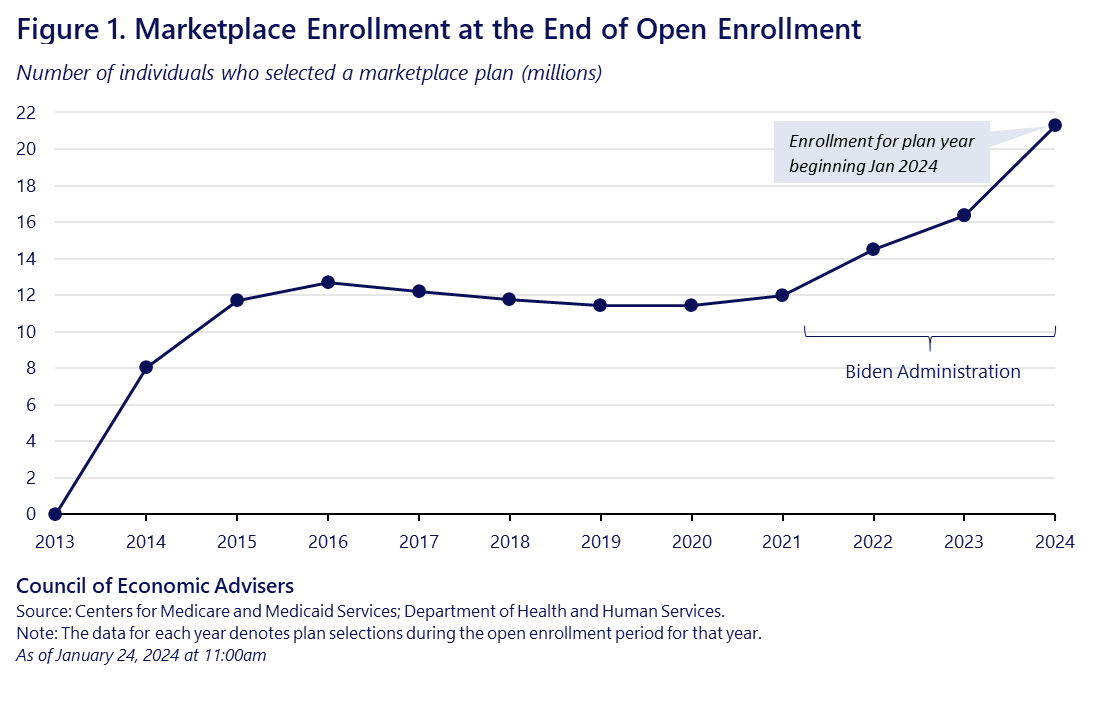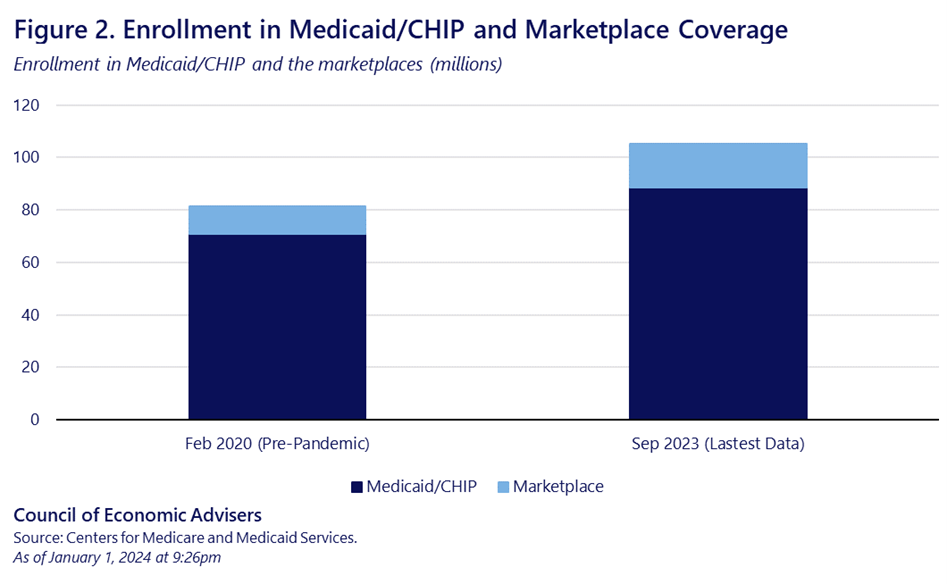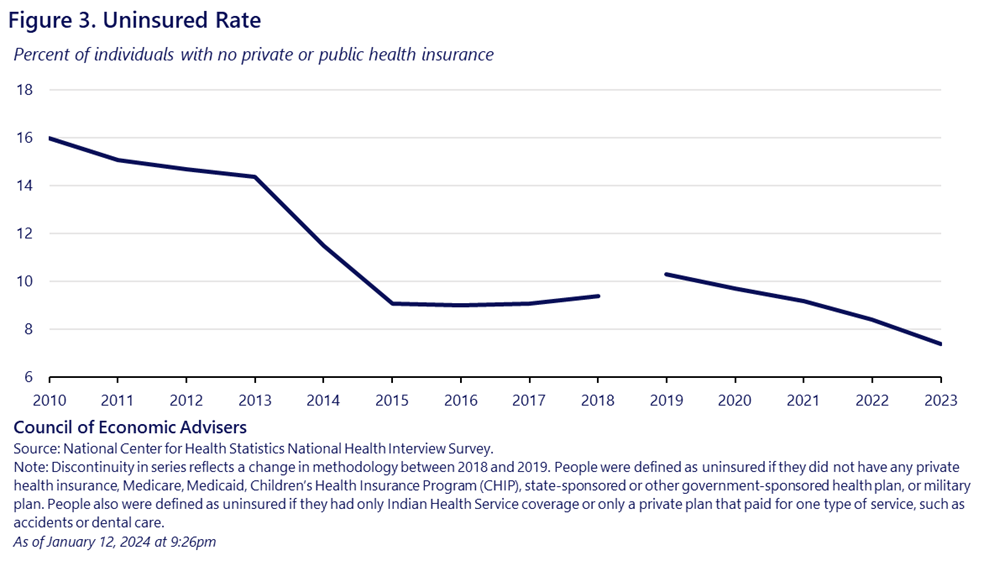Record Marketplace Coverage in 2024: A Banner Year for Coverage
Last week, the Affordable Care Act’s (ACA) Health Insurance Marketplace open enrollment period (during which individuals and small groups can shop for 2024 coverage) closed. Enrollment reached over 21 million for the 2024 plan year—a record high since the launch of the ACA Marketplaces a decade earlier. This trend has occurred in the context of an overall increase in health insurance coverage in recent years, including a decline in the uninsured rate—from 16 percent in 2010, prior to ACA implementation, to 7.2 percent in the most recent data. Health coverage, including public coverage, is important for financial security, dramatically improves health outcomes, and has wide-ranging and long-term benefits for children. In this blog, we highlight the policy decisions that led to three consecutive years of record-breaking Marketplace enrollment, and place this trend in the broader context of insurance coverage trends overall, including changes in Medicaid enrollment and historically low rates of people without insurance.

After an initial ramp up in 2014–2016, ACA Marketplace enrollment had hovered around 12 million through 2021 before surging in 2022, 2023, and 2024. What accounts for the major gains in Marketplace enrollment, relative to the prior four years? In line with its unsuccessful efforts to repeal Obamacare wholesale, the prior Administration took a variety of administrative and regulatory steps intended to undermine ACA Marketplaces, including expanding the availability of junk plans (that provided consumers with lower quality coverage and disrupted the markets) and reversing investments in enrollment assistance and consumer outreach.
The Biden Administration has taken several important actions that together have contributed to the renewed strength of Marketplaces, taking enrollment from 12 million in 2021 to 21.3 million today (see Figure 1). Most significantly, to address consumer prices, the American Rescue Plan (ARP) and the Inflation Reduction Act (IRA) signed by President Biden expanded and extended the advanced, refundable tax credits that help Americans purchase Marketplace insurance. These laws extended the credits to households above 400 percent of the Federal Poverty Line—$120,000 for a family of four in 2023—while making the credits more generous and reducing premiums significantly for people at lower income levels, with premium savings averaging $800 per person per year. Beyond tax credits, the Administration has taken a host of actions to support consumers shopping for Marketplace plans, including fixing the family glitch (where being offered an unaffordable family plan by an employer limited the help available to purchase a Marketplace family plan). The Administration increased funding for the Navigator program to help consumers finds plans that fit them best and expanded investments in broad advertising and outreach efforts. Finally, the Administration eliminated unnecessary paperwork barriers that made it harder to enroll in or keep coverage and made it possible for low-income consumers and those transitioning out of Medicaid to sign up for coverage throughout the year.
Transitions from Medicaid?
Some analysis has noted that the record 2024 Marketplace enrollment could be driven in part by unwinding of the pandemic-era Medicaid continuous coverage rules. So how much of the 2024 plan-year surge in the Marketplaces is due to disenrollment from Medicaid in recent months?
For three years beginning April 2020, the Families First Coronavirus Response Act (FFCRA) suspended the normal renewal process that would otherwise lead to the normal churn and disenrollment of some Medicaid enrollees each month. In April 2023, when this continuous enrollment condition expired and the temporary policy began to unwind, normal eligibility renewal and disenrollment processes by state Medicaid agencies resumed. Since then, Medicaid enrollment has been declining.
Unwinding likely does explain some of the growth from 2023 to 2024. The ACA Marketplaces are an important source of coverage for people who are exiting Medicaid because their income has risen: the ACA was designed to facilitate those kinds of transitions and some states have taken actions to make these transitions easier.[1] Atypically high mid-year growth in 2023 Marketplace enrollment (prior to open enrollment) is consistent with transitions from Medicaid to Marketplace coverage.
Nevertheless, Medicaid unwinding can’t explain most of the Marketplace growth since 2020, especially because much of that growth predates unwinding. Figure 1 shows that Marketplace enrollment grew year-over-year for each of the 2021, 2022, and 2023 open enrollment periods—before Medicaid unwinding began in April 2023.

Today, enrollment remains higher in both Medicaid and the ACA Marketplaces than in 2020, prior to the COVID public health emergency. In the most recent available data from September 2023, Medicaid enrollment was about 88.5 million, compared to almost 71 million in February 2020, prior to the continuous coverage rules implemented in 2020. This means that Medicaid enrollment remains above its pre-pandemic trend growth over the 2017-2020 period.[2] Combining the latest available Medicaid data (September 2023) with Marketplace enrollment from the same time yields an aggregate 105 million, significantly higher than the combined total of 81.4 million in February 2020. Thus, even a half-year into Medicaid unwinding, the number of Americans remaining insured through one of these two channels was substantially higher (see Figure 2) than pre-pandemic. As a whole, the evidence suggests that we are now seeing something closer to the full effect of the Biden Administration’s policies to strengthen Marketplace coverage options, which previously had been partially masked by unusually high Medicaid enrollment due to the COVID-era continuous coverage provisions.
Strong Open Enrollment Should Help Sustain Historic Coverage Gains
Finally, the uninsured rate (the share of persons with no health insurance coverage over the full year) has been at record lows. The most recent whole-year survey data from the Current Population Survey, which covers through end of plan year 2022, placed the uninsured rate at the historic low of 7.9 percent. These data are consistent with other sources, including the National Health Interview Survey (NHIS) and the American Community Survey. More recent partial-year data and CBO projections indicate that the uninsured rate in 2023 was even lower than in 2022, setting a new record for insurance coverage rates. Figure 3 shows the trend in NHIS data, going back to 2010, before the major provisions of the ACA were implemented and caused a rapid decline in the uninsured rate.

While the Figure 3 data predate the 2024 open enrollment period, historic sign-ups for 2024 ACA coverage should help sustain coverage gains, even with the changes associated with the end of the Medicaid continuous coverage provision. In sum, recent coverage trends are consistent with the conclusion that Biden Administration actions have led to greater Marketplace enrollment and contributed to an overall increase in insurance coverage to record levels.
[1] Efforts include cutting red tape for those transitioning out of Medicaid, and automatically enrolling former Medicaid beneficiaries into zero premium Marketplace plans for which they are eligible.
[2] January 2017 Medicaid enrollment was 76.1 million. In January 2020 it was 74.7 million.

